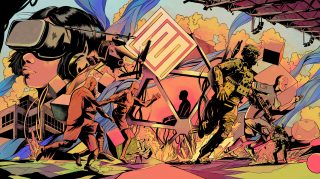Celebrating SEED: A decade of discovery and innovation at EA
Revisit some of the key technological breakthroughs from EA’s applied research & innovation group.
November 18, 2025

Ten years ago, EA launched the Search for Extraordinary Experiences Division (SEED) with a bold mission: to explore, build, and help define the future of interactive entertainment. Partially inspired by EA’s 1983 “We See Farther” ad campaign, which championed software designers and engineers as artists, SEED aims to look beyond today’s approaches and explore deep, foundational technologies that will power the next generation of interactive entertainment. SEED has spent the past decade turning experimental ideas into techniques, tools, and systems that have elevated the way EA games are made and experienced.
As SEED marks its 10-year anniversary, we’re celebrating the team’s pioneering spirit and revisiting some of the remarkable technologies that have redefined what’s possible at EA.

Advancing realism in real time
One of SEED’s earliest breakthroughs came from Project PICA PICA focused on ray tracing, a technique that simulates the physical behavior of light. The project demonstrated photorealistic lighting and reflections years before the technology became standard in games. PICA PICA showed how dynamic global illumination and ray-traced lighting could bring us closer to film-quality visuals with real-time performance.
That spirit of collaboration continued with GIBS (Global Illumination Based on Surfels), which simulates realistic indirect lighting using "surfels" or small, disk-like representations of surfaces. This technology was developed alongside the Frostbite team and implemented in EA SPORTS College Football 25. The technique introduced real-time global illumination for massive, open environments, powering more than 150 stadiums and dynamic day-night cycles without relying on precomputed lighting.
SEED’s advancements also extended into animation. In Madden NFL 21, SEED’s Swish project became one of the first real-time, player-facing machine learning deformer ever shipped in a game. Swish used neural networks to simulate cloth behavior with realistic stretch, flow, and collision, marking the first step toward physics systems that learn instead of being hand-tuned.
Additionally, research for Dragon Age: The Veilguard helped enable higher-quality and more diverse motion data, allowing developers to deliver more expressive characters without compromising performance.

Accelerating creativity through technology
As content creation pipelines grew in complexity, SEED focused on helping artists get to their creative vision faster. Voice2Face, one of SEED’s most widely recognized breakthroughs, introduced an audio-driven facial animation system that generates realistic lip and facial movements directly from recorded speech. Used in Battlefield 6 cinematics and EA SPORTS FC 25 crowd chants, it significantly reduced production time while maintaining quality.
Working alongside internal creative and technology teams, SEED introduced new workflows for LightStage, a cutting-edge scanning technology that allows for the digital capture of the human face with unparalleled fidelity and accuracy. These workflows enabled new levels of realism to character head scanning, allowing artists to capture the finest details and subtle expressions of an actor for in-game models.
Using AI to build smarter systems
From gameplay to operations, SEED’s AI research has reshaped how developers analyze data, optimize testing, and secure player experiences. In EA SPORTS FC 26, the Reinforcement-Learning Goalkeeper introduced adaptive machine learning for goalkeeper positioning, allowing AI to help analyze player movements and make adjustments like their real-world counterparts.
In Apex Legends, Bad Actor Detection systems identified suspected cheating across millions of matches and safeguarded the player experience at scale.
Onwards and upwards
Over the past ten years, SEED has redefined what applied research means in the games industry, transforming experimental ideas into shipping technology and evolving how games are built from the inside out.
From ray-traced lighting and machine learning to generative AI, SEED will continue creating tools and technology in partnership with creators across EA to lead the future of interactive entertainment for the next decade of play and beyond.

